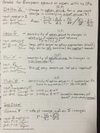Derivatives #49 - Option Markets and Contracts Flashcards
Put-Call Parity
LOS 49.a
put-call parity equation for European options:
C0 + PV(X) = P0 + S0
C<sub>0</sub> = call value today PV(X) = present value of strike price P<sub>0</sub> = put value today S<sub>0</sub> = stock value today PV(X) = X / (1+R<sub>f</sub>)<sup>T</sup>, R<sub>f</sub> = risk-free rate, T = exercise & maturity
synthetic securities
LOS 49.a
Derive from put-call parity equation (e.g. synthetic call):
C0 = P0 + S0 - PV(X)
”+” ⇒ “long”
”-“ ⇒ “short”
reasons for creating synthetic securities
LOS 49.a
- to price options by using combinations of other instruments with known prices
- to earn arbitrage profits by exploiting mispricings among the instruments, i.e.
how to arbitrage using put-call parity
LOS 49.a
- Compare security price to synthetic version of security.
- Short the overpriced one, long the underpriced one
profit is realized immediately; CF’s offset at time T
binomial model: equations for components
LOS 49.b
For stock price binomial tree:
U = size of up move
D = 1 / U = size of down move
For option price binomial tree:
πU = (1 + Rf) - D / (U - D) = risk-neutral prob of up move
π<span>D</span> = 1 - πU = risk-neutral prob of down move
binomial model: option value calculation steps
LOS 49.b
- Calculate U and D; build stock price tree to get stock prices at time T.
- Calculate option payoffs at time T e.g. CT++ = max(0, ST++- X)
- Calculate πU and πD and add to the tree
- Find C0 by working backwards from CT; e.g.:
CT-1 = (π<span>U</span>CT++ + πDCT+-) / (1 + Rf)
binomial model: interest rate caps & floors
LOS 49.b
- interest rate cap (floor) = bundles of European call (put) options on interest rates
- Value of the cap (floor) is the sum of the values of its component caplets (floorlets)
- caplet value = max[0, (rt - rcap)*notional principal] / (1+rt)
- floorlet value = max[0, (rcap - rt)*notional principal] / (1+rt)
assumptions of the Black-Scholes-Merton (BSM) model
LOS 49.c
- price of underlying follows a lognormal distribution
- Rfc is constant and known (bad for bonds and int rate valuation)
- σS is constant and known (not real world)
- markets are “frictionless” (not real world)
- underlying has no CFs (BSM can be altered for this)
- European options only (American options can be priced using binomial option pricing models)
inputs to BSM
LOS 49.c

delta
LOS 49.e
delta - slope of option value
- Call: 0 <= deltaC <= 1
- deep out-of-money: delta aproaches 0
- deep-in-money: delta approaches 1
- Put: -1 <= deltaC <= 0
- deep out-of-money: delta aproaches 0
- deep-in-money: delta approaches -1
- delta (discrete time) = dC / dS
- delta (continuous time) = N(d1)
- dC ≈ N(d1) * dS
- dP ≈ [N(d1) - 1] * dS

dynamic hedging
LOS 49.e
- delta-neutral hedge - combo of long stock and short calls sych that the portfolio value doesn’t change with changing stock price
- # of shorts needed = # shares hedged / deltacall
- HINT: Delta < 1, so we always need more calls than shares
gamma
LOS 49.f
- Gamma = 1st derivative of slope (2nd derivative of option & stock price function)
- largest when option is at the money and close to expiration
- small for deep out-of-money and deep-_in_-money and far from expiration


